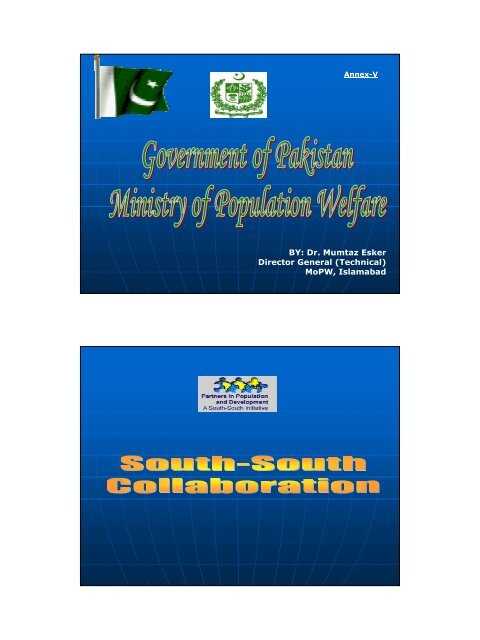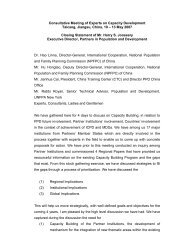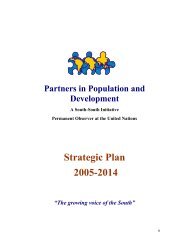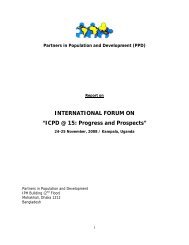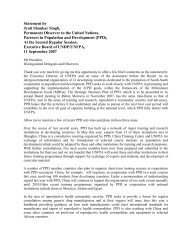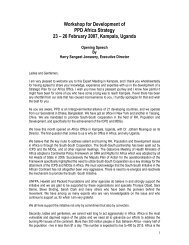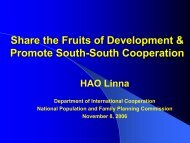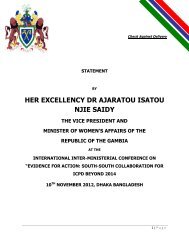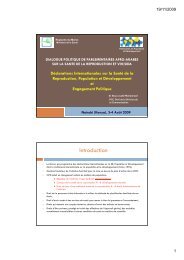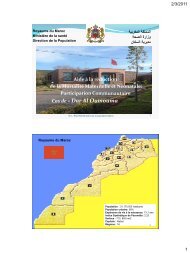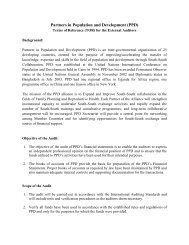presentation by Dr. Mumtaz - Partners in Population and Development
presentation by Dr. Mumtaz - Partners in Population and Development
presentation by Dr. Mumtaz - Partners in Population and Development
Create successful ePaper yourself
Turn your PDF publications into a flip-book with our unique Google optimized e-Paper software.
Annex-V<br />
BY: <strong>Dr</strong>. <strong>Mumtaz</strong> Esker<br />
Director General (Technical)<br />
MoPW, Islamabad
Contents<br />
●<br />
●<br />
●<br />
●<br />
●<br />
●<br />
●<br />
●<br />
●<br />
Preview<br />
Key Issues<br />
Historical Perspective<br />
Track<strong>in</strong>g the status on MDGs Monitor<br />
Why Integration of RH & HIV<br />
Goals of Integrated Services<br />
Evidenced Based Approach<br />
Challenges to Integration of Services<br />
The Way Forward
Preview<br />
• HIV is a global p<strong>and</strong>emic<br />
• The number of people<br />
ple liv<strong>in</strong>g with HIV worldwide<br />
cont<strong>in</strong>ues to <strong>in</strong>crease<br />
• The HIV epidemic is especially severe <strong>in</strong> many<br />
resource-constra<strong>in</strong>ed constra<strong>in</strong>ed countries<br />
• HIV is a virus that destroys the immune system,<br />
lead<strong>in</strong>g to opportunistic <strong>in</strong>fections<br />
• The progression from <strong>in</strong>itial <strong>in</strong>fection with HIV to<br />
end-stage AIDS varies from person to person <strong>and</strong><br />
can take more than 15 years<br />
Preview<br />
• The most common route of HIV<br />
transmission worldwide is heterosexual<br />
transmission<br />
• Women of childbear<strong>in</strong>g age are at<br />
particular risk for acquir<strong>in</strong>g HIV<br />
• Pregnant women who are HIV-<strong>in</strong>fected are<br />
at risk of pass<strong>in</strong>g the <strong>in</strong>fection to their<br />
newborn<br />
• Risk of HIV transmission from mother-to<br />
to-<br />
child can be greatly reduced through<br />
effective PMTCT programs
Key Issues<br />
• Pakistan is <strong>in</strong> a concentrated epidemic of<br />
HIV, driven <strong>by</strong> <strong>in</strong>ject<strong>in</strong>g drug users, male<br />
& transgender sex workers with high risk<br />
population <strong>and</strong> migrant workers<br />
• In addition, Pakistan has one of the<br />
largest cohorts of young people <strong>in</strong> the<br />
world – 60% of the nearly 163 Million are<br />
under the age of 24 years<br />
• These young people need correct<br />
<strong>in</strong>formation on HIV <strong>in</strong> order to protect<br />
themselves <strong>and</strong> their peers<br />
Historical Perspective<br />
• ICPD (Cairo Egypt-1994)<br />
- Effective Prevention & Treatment of STIs<br />
an Integral Component of RH<br />
- Key Programmatic L<strong>in</strong>kage between FP &<br />
Prevention of HIV <strong>in</strong> Women & Children<br />
as<br />
• Millennium <strong>Development</strong> Goals - 2000<br />
- MDG 6 To halt & beg<strong>in</strong> to reverse HIV <strong>by</strong> 2015<br />
• Glion (Switzerl<strong>and</strong> May 2004)<br />
- Strengthen the L<strong>in</strong>kages between SRH <strong>and</strong><br />
HIV/AIDS
Historical Perspective<br />
• International Forum of PPD at<br />
Kampala (Nov 2008)<br />
25y - <strong>in</strong>to AIDS Epidemic<br />
½ -way through the MDG targets<br />
Women >60% liv<strong>in</strong>g with AIDS<br />
Provid<strong>in</strong>g access to RH to women with HIV/AIDS<br />
can reduce #s of un<strong>in</strong>tended pregnancies which<br />
leads to mother-to<br />
to-child-transfer<br />
MDG 1<br />
MDG 2<br />
MDG 3<br />
MDG 4<br />
MDG 5<br />
MDG 6<br />
MDG 7<br />
MDG 8<br />
Track<strong>in</strong>g the current status on<br />
MDG Monitor*<br />
MDGs<br />
Current Status & Progress towards<br />
achiev<strong>in</strong>g Goals (Pakistan)<br />
Possible to achieve if some changes are made<br />
Possible to achieve if some changes are made<br />
Off track<br />
Possible to achieve if some changes are made<br />
Possible to achieve if some changes are made<br />
Very likely to be achieved; on track<br />
Possible to achieve if some changes are made<br />
Insufficient <strong>in</strong>formation<br />
*UN MDG monitor to Track MDGs
Barriers <strong>in</strong> the Progress on<br />
MDGs*<br />
• Macro-economic Imbalance<br />
• Widen<strong>in</strong>g Disparities <strong>in</strong> Social Indicators<br />
• Spiked Inflation a recent phenomena<br />
• Sharp <strong>in</strong>creased Liabilities of Public accounts<br />
• Grow<strong>in</strong>g Deficit<br />
*UNDP 2007<br />
*Why Integration of RH & HIV<br />
• People come <strong>in</strong> contact with RH<br />
service providers more often<br />
• Opportunity for At-Risk population<br />
• Seek<strong>in</strong>g Information<br />
• Counsel<strong>in</strong>g<br />
• Condoms Promotion<br />
• Management of STIs<br />
• Contraceptive Service<br />
• HIV/AIDS services offer opportunities<br />
for access to SRH services<br />
* Advocacy Summit on Global Fund,2006:<br />
Integration of RH & HIV
Why Integration of RH & HIV<br />
• FP / RH are essential tools <strong>in</strong><br />
reduc<strong>in</strong>g the spread of HIV & AIDS<br />
• FP is effective & affordable<br />
<strong>in</strong>terventions for prevent<strong>in</strong>g Mother<br />
to Child Transmission<br />
• Efficient way to promote wanted,<br />
healthy pregnancies, improve child<br />
health <strong>and</strong> prevent disease<br />
<strong>Population</strong> action <strong>in</strong>ternational 2006<br />
Goals of Integration of RH & HIV<br />
• Integrated services can help to de-<br />
stigmatize HIV/AIDS whilst simultaneously<br />
address<strong>in</strong>g the dual need for both services<br />
& care<br />
• Better <strong>and</strong> clearer underst<strong>and</strong><strong>in</strong>g of cost-<br />
effectiveness that is crucial to quickly<br />
scale up <strong>and</strong> serve more women <strong>and</strong> men<br />
• Scal<strong>in</strong>g-up <strong>in</strong>tegration between these<br />
parallel programs will accelerate progress<br />
towards achiev<strong>in</strong>g MDGs 4,5 & 6<br />
Advocacy summit on <strong>in</strong>tegraion of RH &<br />
HIV,2006
Evidence Based L<strong>in</strong>kages<br />
• Results of 58 studies show*:<br />
• Improved access & uptake of both<br />
services<br />
• Improved Health & Behaviour<br />
• Increased Condoms use<br />
• Improved RH & HIV Knowledge<br />
• Overall improved Quality Services<br />
• Cost- effectiveness<br />
L<strong>in</strong>kages:Evidence Review &<br />
Recommendation WHO,2008<br />
Challenges to Integration of<br />
Services<br />
• Lack of tra<strong>in</strong>ed Health Personnel<br />
• Understaffed cl<strong>in</strong>ics<br />
• Lack of Commitment & Providers<br />
Bias<br />
• Stigma prevent<strong>in</strong>g clients from<br />
utiliz<strong>in</strong>g services<br />
• Reduction <strong>in</strong> Donors’ Fund<strong>in</strong>g<br />
• Separate Fund<strong>in</strong>g schemes for RH &<br />
HIV/AIDS
Actions Taken <strong>by</strong> MOPW<br />
• Included <strong>in</strong> National St<strong>and</strong>ards<br />
• Be<strong>in</strong>g Taught <strong>in</strong> Basic Course of<br />
Paramedics<br />
• Practiced at Service Delivery Outlets<br />
• Given Coverage <strong>in</strong> Outreach<br />
Programs<br />
• IEC materials availability is ensured<br />
• Awareness rais<strong>in</strong>g at all levels<br />
The Way Forward …….<br />
• Advocacy for awareness of <strong>in</strong>tegration of<br />
RH & HIV<br />
• Ongo<strong>in</strong>g Human Resource <strong>Development</strong> &<br />
Capacity Build<strong>in</strong>g<br />
• <strong>Partners</strong>hip build<strong>in</strong>g & jo<strong>in</strong>t <strong>in</strong>itiatives for<br />
susta<strong>in</strong>ability of the program<br />
• RH & HIV <strong>in</strong>tegration as a Best Practice
The Way Forward……<br />
…….<br />
• Increased female participation <strong>in</strong> decision mak<strong>in</strong>g<br />
<strong>in</strong> HIV prevention<br />
• Engagement of Key <strong>Population</strong> players<br />
• Positive Attitudes to De-stigmatize Services<br />
• Women Empowerment for better outcomes<br />
• Male <strong>in</strong>volvement for Responsible Behaviors<br />
In Conclusion<br />
• The RH needs of People <strong>and</strong> of Country<br />
are constantly chang<strong>in</strong>g<br />
• Bus<strong>in</strong>ess as usual will not curb the spread<br />
• Both need a multisectoral approach<br />
• Capitalize on new challenges <strong>and</strong> new<br />
opportunities<br />
• Special focus on improvement of Health<br />
System <strong>and</strong> removal of bottlenecks
In Conclusion<br />
• SRH & HIV <strong>in</strong> targeted programs for young<br />
people & key vulnerable groups<br />
• Shift focus on health outcomes rather than<br />
<strong>in</strong>puts<br />
• Address the range of unmet need & missed<br />
opportunities <strong>in</strong> RH <strong>in</strong>clud<strong>in</strong>g HIV / AIDS<br />
An old say<strong>in</strong>g is that<br />
The best time to<br />
plant a Tree was 20<br />
Years back<br />
The second best<br />
time is Now


